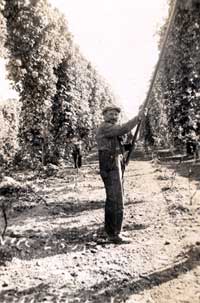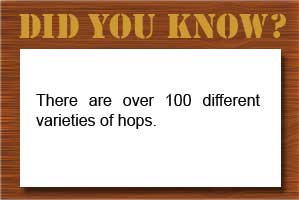
The process of growing and harvesting hops has changed little over the last century. The vines must still be trained to grow up coir string and travel along overhead wires. When ripe, the vines must still be cut and the hop cone removed from the vine. Hops are still dried in kilns and breweries still receive their hops in 200 pound bales.
Spring Cultivation
The yearly cycle begins in the spring with cultivating. After the fields are tilled, the rootstalk is planted or if already growing, is trained to grow up coir string to overhead wires. Coir string is made from coconut fibres and is course enought that the vines easily attach to it. By August the fast growing vines are ready for harvest. (Photo: Manure spreading)
Stringing
The hop vines were trained to climb poles or strings.
Spraying
Hops were susceptible to viruses, pests and fungal diseases. So spraying was done to prevent spider mites, aphids and downy mildew. Spraying methods have changed from horse-drawn spray units to modern crop-dusting airplanes. (Photo: Spraying Hops)
Picking and Weighing
Before mechanical picking machines were introduced in the 1950's, harvest crews picked the hops by hand. The vines are dropped, the cones stripped and placed into baskets.
After the hops were weighed, the scaler would read the weight off the scale and punch the weight on a company issued ticket to determine the value, so much per pound. You could buy groceries at the hop yard store and receive some change or wait until the end of the season and cash in the tickets at the hop yard office. Lorna and Cecil Shaw remember that as storeowners, this often presented difficulties for them since they carried the cost of buying supplies while they couldn't cash the tickets in with the hop companies until the end of the season.
Online exhibit (c) Chilliwack Museum and Archives 2008. About the Exhibit


